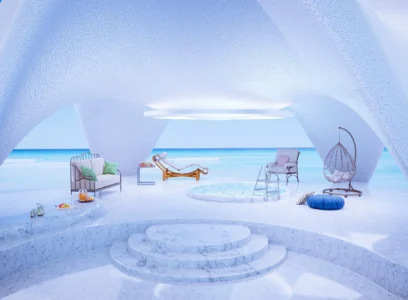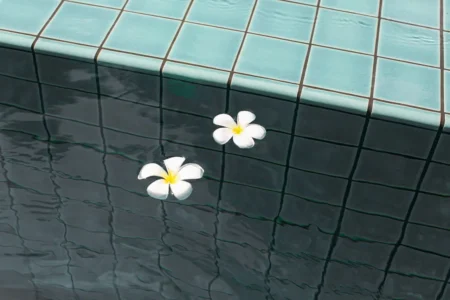If you have a swimming pool in your backyard, you know how important it is to choose the right tiles for the pool area. The tiles you select will not only affect the appearance and style of your pool but also its safety, durability and maintenance. But with so many options available in the market, how do you decide which tiles are best for your pool area? In this blog post, we will help you answer this question by providing some useful tips and ideas on how to choose the right tiles for your pool and avoid costly mistakes.
Which Tiles are best for the pool area?
Tiles for swimming pools can be made of different materials, such as vinyl, ceramic, porcelain, granite and glass. They can also vary in size, from small mosaic tiles to large rectangular tiles. The choice of tiles may depend on the pool’s design and maintenance needs. Here are some factors to consider when choosing tiles for your pool area:
- Slip-resistance: Most outside areas require tiles with a P4-P5 slip rating, depending on the application. This means that the tiles have a textured surface that prevents slipping hazards, especially when wet. Slip-resistant tiles are essential for safety and comfort around the pool.
- Wear rating: Poolside environments can be quite harsh given the exposure to chemicals and the changing weather. Make sure your tiles or pavers are strong enough to cope by choosing a style with a high wear rating. This indicates that the tiles can withstand abrasion and impact without cracking or chipping.
- Water-resistance: Any area near a swimming pool will be exposed to water. Make sure your tiles or pavers won’t be damaged by regular exposure. Water-resistant tiles are less likely to absorb water and stain or warp over time.
- Comfort: Some materials are hotter underfoot than others when the sun beats down on them. For comfort underfoot, opt for light pavers or tiles in natural materials such as travertine, limestone, or sandstone – they’re up to 30 per cent cooler than other types of natural stone or concrete pavers.
- Maintenance: Sealing tiles and pavers makes them much easier to clean. Alternatively, consider pre-sealed tiles such as porcelain. Porcelain is pre-sealed and it has a smooth, easy-to-clean surface. Size also counts; larger slabs have fewer grout lines than small tiles, which means less elbow grease is required to keep them pristine.
How to Choose the Right Tile for Your Pool and Avoid Costly Mistakes
Now that you know what to look for when choosing tiles for your pool area, here are some tips on how to avoid common mistakes that can cost you time and money:
- Plan ahead: Before you start shopping for tiles, measure your pool area and sketch out a layout of how you want it to look. This will help you determine how many tiles you need and what size and shape they should be. You can also use online tools such as tile calculators or visualisers to help you plan your project.
- Match your style: Choose tiles that complement the style and colour scheme of your pool and your home. For example, if you have a modern pool with clean lines and minimalistic features, you might want to go for sleek and simple tiles in neutral tones. If you have a traditional pool with curves and details, you might prefer more ornate and colourful tiles that add some flair.
- Consider the waterline: The waterline is the area where the water meets the tile on the wall of the pool. It is important to choose a tile that contrasts well with the watercolour and creates a visual impact. For example, if you have a blue pool, you might want to choose a white or light coloured tile for the waterline to create a crisp and clean look. If you have a green or dark-coloured pool, you might want to choose a bright or metallic tile for the waterline to add some sparkle and shine.
- Mix and match: Don’t be afraid to mix and match different types and styles of tiles for your pool area. You can create interesting patterns and effects by combining different shapes, sizes, colours and textures of tiles. For example, you can use mosaic tiles as an accent or border around the pool, or place them around the steps or corners for some added detail. You can also use different materials such as glass or stone to create contrast and texture.
Trending Pool Tile in 2023
If you want to give your pool a fresh and trendy look, you might want to check out some of the latest pool tile trends for 2023. Here are some of the styles that are making waves in the pool design world:
- Simulated stone: Porcelain tiles that mimic the appearance of natural stone are a great way to add some texture and warmth to your pool area. They come in various colours and patterns, such as slate, travertine, marble and granite. They are also durable, water-resistant and easy to maintain.
- Hexagon tile: This geometric shape is a modern and stylish choice for pool tiles. Hexagon tiles are made of porcelain or glass, and they have a smooth and glossy finish. They come in many colours, from classic blue to metallic silver. They can create a honeycomb effect or a mosaic pattern on your pool wall or floor.
- Black tile: For a sleek and luxurious look, you can’t go wrong with black tile for your pool. Black tiles can create a dramatic contrast with the water and the sky, and give your pool an illusion of depth. They can be made of porcelain, glass or natural stone, and they can have a matte or glossy finish.
- Patterned patchwork: If you want to add some personality and flair to your pool, you might want to try patterned patchwork tiles. These are glass tiles that come in different shapes, sizes, colours and designs. You can mix and match them to create a unique and eclectic look for your pool. They can also add some colour and movement to your pool water.
- Cosmic watercolour: For a truly ethereal and stunning look, you can opt for cosmic watercolour tiles. These are glass tiles that have a glossy and iridescent surface that reflects light and creates a rainbow effect. They have a mix of pastel and galaxy colours that swirl and melt into each other like the aurora borealis. They can make your pool look like a magical wonderland.
How to care for and maintain pool area tiles?
Once you have chosen and installed your pool tiles, you want to keep them looking clean and shiny for as long as possible. Here are some tips on how to care for and maintain your pool area tiles:
- Clean regularly: The best way to prevent stains and buildup on your pool tiles is to clean them regularly. You can use a mild detergent and a soft-bristled brush, or a specialized pool tile cleaner. Avoid using harsh chemicals or abrasive tools that can scratch or damage the tile. You should also brush the tiles along the waterline at least once a week to prevent calcium deposits and algae growth.
- Balance the water: Another important factor in maintaining your pool tiles is to keep the water chemistry balanced. You should test the water’s pH, alkalinity, hardness and chlorine levels regularly and adjust them as needed. Unbalanced water can cause corrosion, scaling, staining and algae problems on your pool tiles. You can use a pool test kit or a digital tester to check the water quality.
- Remove organic matter: If your pool has leaves, grass clippings or other organic matter in the water, you should remove them as soon as possible. Organic matter can decompose and create acids that can damage your pool tiles. You can use a pool vacuum or a skimmer net to remove the debris from the water surface and the bottom of the pool.
- Seal the tiles: If you have natural stone tiles, such as travertine, limestone or marble, you should seal them after installation and every year thereafter. Sealing the tiles will protect them from water absorption, staining and fading. You can use a penetrating sealer or a topical sealer depending on the type of stone and the finish you prefer.
- Repair the tiles: If you notice any cracks, chips, or loose tiles in your pool area, you should repair them as soon as possible. Damaged tiles can allow water to seep behind them and cause further damage to the tile and the pool structure. You can use a waterproof adhesive or grout to fix the tiles, or hire a professional if the damage is extensive.
Conclusion
Choosing the right tiles for your pool area can make a big difference in the look and feel of your backyard oasis. Whether you want a classic blue pool or a trendy patterned pool, you can find the perfect tiles to suit your style and budget. Just remember to follow the tips and ideas we shared in this blog post to choose the right tiles for your pool and avoid costly mistakes. And don’t forget to care for and maintain your pool tiles regularly to keep them sparkling and beautiful for years to come.
FAQs
What are the benefits of using tiles for the pool area?
Tiles are a great choice for the pool area because they are durable, water-resistant, slip-resistant, easy to clean and maintain, and come in a variety of colours, shapes, sizes and styles. Tiles can also enhance the appearance and value of your pool and your home.
What are the different types of tiles for the pool area?
There are many types of tiles for pool areas, such as vinyl, ceramic, porcelain, granite, glass and natural stone. Each type has its own advantages and disadvantages, depending on the pool’s design and maintenance needs. Some of the factors to consider when choosing tiles for the pool area are slip resistance, wear rating, water resistance, comfort, maintenance and style.
How to choose the right colour for pool tiles?
The colour of pool tiles can affect the mood and atmosphere of your pool area. It can also change the appearance of the watercolour and create a visual impact. Generally, blue tiles are the most popular choice for pool tiles because they match well with the water and create a calm and relaxing vibe. However, you can also choose other colours that suit your personal preference and style. For example, you can choose white or light-coloured tiles for a crisp and clean look, bright or metallic tiles for a sparkling and shiny look, or black or dark-coloured tiles for a sleek and luxurious look.
How to clean and maintain pool tiles?
To keep your pool tiles looking clean and shiny, you should clean them regularly with a mild detergent and a soft-bristled brush, or a specialized pool tile cleaner. You should also brush the tiles along the waterline at least once a week to prevent calcium deposits and algae growth. Moreover, you should balance the water chemistry regularly and adjust the pH, alkalinity, hardness and chlorine levels as needed. Unbalanced water can cause corrosion, scaling, staining and algae problems on your pool tiles. Finally, you should seal the tiles if they are made of natural stone to protect them from water absorption, staining and fading.
How to repair damaged pool tiles?
If you notice any cracks, chips or loose tiles in your pool area, you should repair them as soon as possible. Damaged tiles can allow water to seep behind them and cause further damage to the tile and the pool structure. You can use a waterproof adhesive or grout to fix the tiles, or hire a professional if the damage is extensive.


